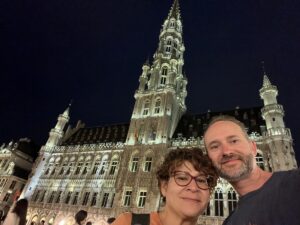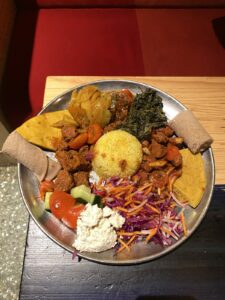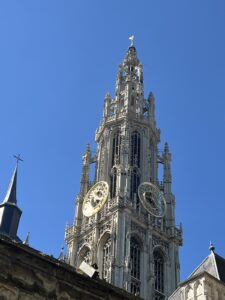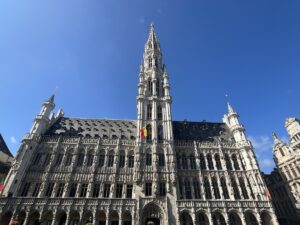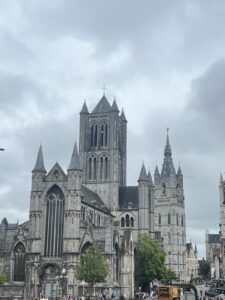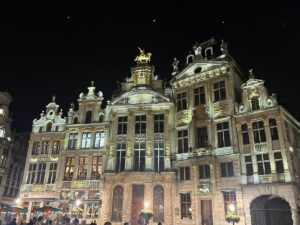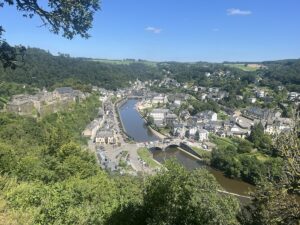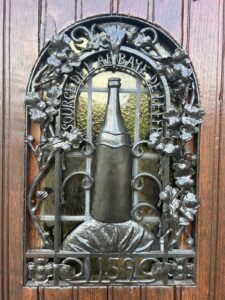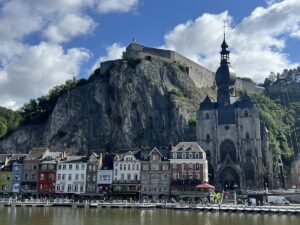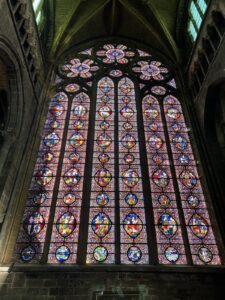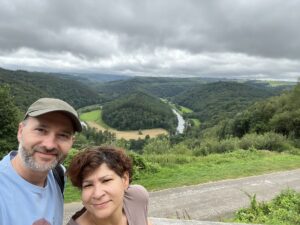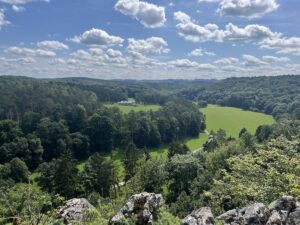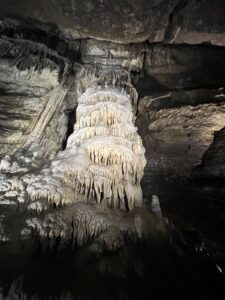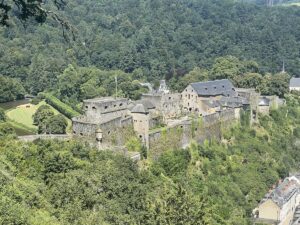While not all about beer, this holiday was rather beer-centric at times 🙂 Most people will agree that Belgium and Germany make the best beer in the world. Many breweries in Belgium have been brewing for several hundred years — a few even close to one thousand years. While most of them are no longer in the “craft” or “micro” category they still produce beer of the highest quality. No matter where we are in the world, if the restaurant or bar offers a Belgian beer, that is typically what we order. Many of the Belgian beers were not new to us. However, enjoying them on draft instead of bottle, and tasting rare offerings difficult to find outside of Belgium, made the experience remarkable. We find the whole abbey/trappist heritage fascinating. If you are not familiar with beer history, monks in the Middle Ages had alot of free time. Some groups of monks started brewing beer in order to 1) make some money to support the monastery and community and 2) because most drinking water back then was unsafe for human consumption. When monks do something, they dedicate considerable time studying and innovating. The result — world-renowned beers.
We decided to split the trip between rural and city. Once at the airport we picked up a rental car and headed out to the southern countryside of Belgium, known as the Ardennes Forest region. There are no cities in this part of the country, only small villages. We stayed in Rochefort which has a main street of 3-4 blocks and that’s about it. The location was a good launchpad for exploring the region. However because it was August, holiday month in all of Europe, it was difficult to find open restaurants.
We explored the village of Bouillon first. We hiked the surrounding forest, some stretches along the Semois River, and up into the hills, highlighted by a gazebo on a hilltop that overlooked the town and valley. Back in Rochefort of course we had to do a tasting of the Rochefort Trappist beer which went nicely with a thick-cut steak served with mushroom gravy.
The next day, we drove to the Domaine des Grottes de Han. The property is vast and features some caves and a wildlife park. The cave tour featured impressive, large rooms with beautiful formations but the highlight was a very well-produced LCD projection light show on the ceiling and walls of the largest room. The room was immense, nearly as big as a sports arena. After the caves, we walked the wildlife park. It was a bit warm so most of the animals were resting. The arctic wolves and bears shockingly did not seem phased by the warm day. We planned to walk the entire park – nearly a 10 km loop – but half way through we started to tire. To our pleasant surprise, there was a small tram that traversed the savannah-like valley floor full of various species of deer, elk, cattle and dropped us at the brown bear habitat. Our feet were thankful. Maybe 1 more km and we returned to the trolley that took us back to the park entrance. We finished the day with a nice beer from a local co-op brewery, Brasserie de la Lesse, in the village of Eprave.
Another day, another hike in the Ardennes – the Giant’s Tomb Loop, near Rochehaut. The legend is that a local hero helping defend the village against the conquering Roman soldiers threw himself from the cliffs instead of being captured, enslaved, and forced to fight in the Colosseum. The villagers retrieved his body the next day and buried him on top of the hill in the middle of the horseshoe bend in the Semois River. A lovely hike along the river and through the forest.
On our final day in the Belgian countryside before heading to the big city of Brussels, we stopped off in the village of Dinant. We anticipated spending only an hour or two here but ended up really enjoying our time and spent most of the day. Situated along the Meuse River, Dinant is full of charm. Down by the river, a row of traditional Belgian brick houses make for a great photo-op and directly behind the houses is a stunning rock cliff with an even more stunning medieval fortress on top. To most normal people, Dinant is famous for being the birthplace of the inventor of the saxophone – Adolphe Sax. But we are abnormal and for us Dinant is famous for the location of one of the oldest breweries in the world — the Leffe Monastery (Abbaye Notre-Dame de Leffe). At Leffe House (Maison Leffe) there is a museum and beer garden. With admission to the museum, you get a free glass of any Leffe beer of your choice and a free Leffe chalice as a souvenir. For me, Dinant was definitely one of the highlights of this vacation.
That concludes the Ardennes/country portion of our trip, now it’s time to explore some of the big cities and use trains and light rail to get around. Our home base for the next few days will be an apartment in the center of Brussels, about a 10 minute walk from Grand Place, one of the most incredible city center plazas I have ever seen. While we had our fair share of frites (french fries topped with all kinds of stuff — kind of like nachos) and waffles (those never get old), it was nice to be in a city and have access to a more diverse offering of culinary delights. I won’t bore you with all the sights, but what I do want to share about Brussels is the Wolf Food Market. A food court with elevated offerings from all over the world. So hard to choose just one, but we went with the Ethopian vendor and it did not disappoint. Very cool spot.
Brussels has an extensive commuter train network which we used for a couple of day trips. First off, we hopped over to Ghent. We took the advice of some Belgians who said skip Bruges — Ghent is just as good and without the crowds. And yeah, it is pretty amazing. Some light rain started when we exited the train. We didn’t bring an umbrella or even a jacket because the forecast indicated another warm day. After waiting the rain out in a couple of different shops, it did finally ease up and eventually the sun did come out. Our spirits lifted and we were ready for some waffles 🙂 Walking around Ghent is like walking in a fairy tale. The towering spires of churches and clock towers, the stone bridges over canals lined with brick houses with steep roofs and lots of ornate stone work. The whole town is an artistic masterpiece.
For our other day trip by train, we visited Antwerp. It featured some of the same majestic elements as Ghent but it definitely had its own character. As soon as you exit the train, the Central Station commands your attention with a ceiling of intricate iron and glass work. Because of its large port, the city definitely feels more like a place of trade and business and feels less touristy than Ghent eventhough we didn’t venture much outside of the tourist areas. The Cathedral of Our Lady towers and I mean really towers by a dramatic margin over all the other surrounding buildings in the Historic Center district. Something happened in Antwerp that made me feel pretty uncomfortable. At a flea market in one of the plazas, a couple of vendors were selling Nazi artifacts/memorabilia. Photos of Nazi soldiers, SS pins and badges, helmets with swastikas painted on the side, etc. The items were incognito, not completely hidden, but maybe a piece of tape covering part of the swastika but you knew what it was anyways, or a piece of cloth over a collection of SS badges. It just didn’t settle well with me and made me wonder if the far-right resurgence we are seeing in many countries is emboldening people and they are attempting to normalize these symbols of hate. I don’t know, that is just how it made me feel.
Anyways, to recap our Belgian holiday, it was a fun adventure of trains, excellent beers, lots of great food, and some awe-inspiring sights of the natural and man-made variety. I think it is a country we will come back to at some point in the future — maybe for a bikepacking tour 🙂 That’s all for now…stay tuned for more adventures 🙂
